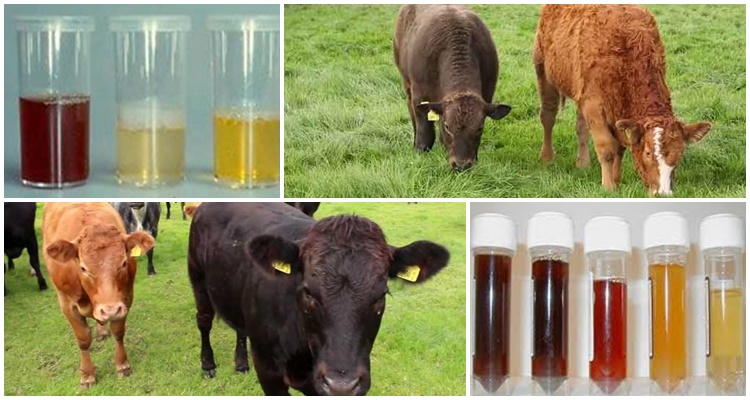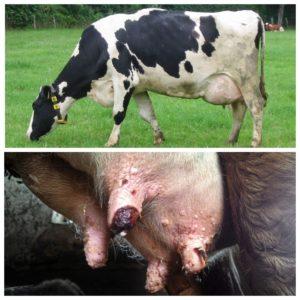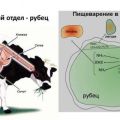Why does a calf have red urine and it pees with blood, what to do
The reproduction of the herd and the milk production of cows depend on the health of the reproductive and urinary system of cattle. In order not to miss the problem, you need to monitor the condition of the queens and calves after calving. Let's consider why the urine of a calf is red, what diseases cows can get sick after calving, what to do to help the animals.
Why and what to do if calves have bloody urine
Urine becomes red with hematuria - erythrocytes are released into the urine, which normally should not be there. Hematuria occurs most often in cows after 1-2 calving and in calves 4-5 months of age. In calves, the cause of the disorder may be drinking a lot of water at a time or drinking cold or hot water. The kidneys cannot cope with the load, their work is disrupted. Treatment is simple - give calves water at normal temperature, often in small portions.
However, sometimes hematuria in calves can be a sign of piroplasmosis, it is possible to distinguish an infection from a violation of the drinking regime by the behavior of the animal - if it is active, eats well, the temperature is normal, it is healthy. With piroplasmosis, a calf or an adult animal is depressed, does not eat and moves a little. A veterinarian should diagnose piroplasmosis and treat it.
In cows that have given birth, hematuria is also a sign of kidney and urinary tract pathologies. Diseases can be a complication and consequence of infectious diseases of the reproductive organs, in particular the uterus.
Subinvolution of the uterus
This is one of the complications in the postpartum period, when the uterus is delayed in returning to its normal size, which was before pregnancy. Bleeding is a symptom of pathology, while blood is secreted from the uterus, and not from the urinary tract. But the cow may appear to be peeing with blood in urine as the secretions are mixed with the urine.

Infection may be the cause of the subinvolution of the uterus. Treatment is with antibiotic therapy to eliminate inflammation. The pathology is characteristic only of cows that have given birth, and is not the cause of the problem if the calf pees with blood.
Endometritis
Inflammation of the inner layer of the uterus is mainly a postpartum complication, but it can also develop as a result of infection from other urogenital organs.Endometritis in a cow can occur due to complicated childbirth, delayed afterbirth, the birth of a dead calf, and multiple births.
Inflammation can be caused by poor hygiene during the calving process, as well as poor nutrition before and after childbirth.
In cattle, several types of endometritis are recorded: catarrhal, purulent-catarrhal and acute fibrous. The disease is acute and subacute. For treatment, antibiotics and hormone-like substances are used.
Chronic endometritis
Inflammation of the uterus of a chronic nature may not show symptoms, that is, it may proceed latently. Temporarily, it can manifest itself as complications in the form of cycle disturbances, ovarian dysfunction and inability to conceive, signs of intoxication. Chronic endometritis can be the result of inflammation in the vagina, a decrease in immunity, the infection enters the cattle body due to non-observance of the rules of care, when cows in stalls lie on a dirty bed.
Urine interspersed with blood in cows with endometritis may appear if the infection has got not only into the uterus, but also into the urinary tract, and the kidneys, and there is inflammation in them. The offspring - a bull or a heifer - do not suffer at the same time, the reasons for the appearance of red urine must be sought in something else.
Latent endometritis
This is a form of endometritis that runs latently, without symptoms, so it is difficult to detect it. It is usually diagnosed in animals after several failed inseminations in a row. Endometritis adversely affects reproductive function, as well as the quality of dairy products. There is less milk, its taste and composition deteriorate. However, milk does not affect the fact that the calf feeds with blood.

Vestibulitis
Inflammation of the mucous membrane of the vestibule of the vagina proceeds in several forms. In acute diphtheria vestibulitis, a brown liquid with an admixture of blood and pieces of mucous membrane is released from the affected organ. The animal's temperature is elevated, there is no appetite or it is reduced, a depressed state.
Thus, the blood during vestibulitis is not in the urine, but gets there from the vagina.
Prevention measures
So that the calf's urine is not red, but of a normal color, you need to properly feed and water it. The calf can drink a lot of water at a time, but it should not be allowed to drink as much as it wants. It is recommended to drink it more often 3 times a day, but little by little, in portions of 3-4 liters. The water temperature should be moderate.
You can not feed him red beets, which can also stain urine in a dark color. If, after canceling the diet with red-colored vegetables or normalizing the drinking regime, the problem has not disappeared, then you need to look for the reason elsewhere. Blood in the urine may indicate the development of piroplasmosis.
As for dairy cows, diseases of the internal organs, inflammation of the reproductive and urinary organs must be prevented by maintaining cleanliness in the barn, especially where cows and calves stand. After all, the infection enters the body of healthy animals from the outside. When animals are standing and lying on a clean bed, they are less likely to become infected.
Red urine is a sign of kidney problems. The reason may be improper feeding or watering of calves, an infectious disease of internal organs in cows. In any case, blood in the urine is a reason to pay attention to the health of the animal and start treatment as soon as possible.












